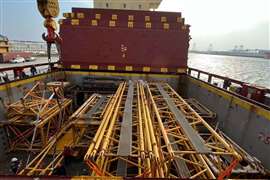Truck cranes: wheels of fortune
21 March 2016

Several types of wheeled mobile crane, all with telescopic booms, are competing for buyers in the capacity range between about 25 and 60 tonnes or so. It is a market sector in transition. Ian Valley reports
What we are primarily talking about here are traditional purpose-built truck cranes and cranes mounted on standard commercial carriers, known as truck mounted cranes or boom trucks. All terrain cranes at the bottom of the capacity range, so-called straight boom hydraulic loader cranes, and even some larger articulating or knuckle boom cranes mounted on tractor units are also competing in this sector. Also, in some markets, there are mini roughter small RT cranes and Franna type pick and carry cranes.
The focus of this article is on the first two types, where the traditional capacity boundaries are becoming increasingly blurred for purpose-built truck cranes and truck-mounted boom truck types. Both use truck type running gear and axle configurations. Truck makers are constantly making technical advances in reducing weight and increasing the strength and capacity of their chassis-cab units which is eroding the need for specialist low-volume carriers. The effect is that manufacturers of truck mounted or boom truck cranes are pushing their upper capacity limits, now over 40 and even up to around 70 tonnes.
Arguably, the distinction between the two is becoming increasingly hazy; some believe that that lower capacity truck cranes and all terrain cranes are slowly being replaced by truck mounted or boom truck cranes. Rick Curnutte, product manager for truck and all terrain cranes at manufacturer Link-Belt in the USA, says, “For North America, below 35 metric tonnes are predominately boom trucks. The lines blur between 35 and 50 metric tonnes; truck cranes are still strong in this class.”
While there is evidence of convergence, differences between the two types of crane remain. This begs a question: which is best – mounting the crane on a purpose-built carrier (a truck crane), or on a standard commercial chassis-cab (truck-mounted crane)?
For Link-Belt’s Curnutte, it’s a no-brainer, “A truck crane, by definition, is a purpose-built chassis. This means we can integrate the lifting performance of a truck crane into the transportation performance of the crane. When Link-Belt designs a truck crane, we are building a crane from the ground up. We are able to move axles or change the frame design in order to get the best transport and lift performance.”
Tadano has been developing and manufacturing truck cranes since 1979. Its spokesperson says, “Compared with a standard commercial chassis, a purpose-built chassis truck crane has advantages in terms of dimensions and weight. The reasons for this are that the structure of the frame and layout of components (such as the engine and cab) are more suitable.”
Terex’s spokesperson, however, disagrees, “Commercial chassis are supported by a large distribution and support network. They also offer increased comfort for drivers (through, for example, a spacious cabin) and the ability to customise the chassis for the region and-or application.
“For example, it is common to mount a [Terex] Crossover on a twin-steer chassis for Canada. It is also possible to mount on a chassis with a sleeper cab which is common for jobs lasting for an extended period of time. This way, the carrier can be customised to the customer’s needs.”
At Manitex, Randy Robertson, director of sales and marketing, believes a standard commercial chassis offers solid benefits to operators. For example, he points to the fact that it can be tailored to meet local or regional road requirements in just about any country in the world. And, he says, “Lift axles can be easily added to meet road weight requirements; commercial chassis can be serviced at most truck dealer or local repair shops, or even truck fuel stops, and chassis replacement parts are more readily available.”
Robertson adds, “Truck mounted cranes are much more cost-effective and cost less to maintain than traditional truck cranes and, particularly, all terrain cranes.”
Indeed, perhaps unsurprisingly since they manufacture them, all our spokespeople agree that, in certain applications, both truck cranes and boom truck cranes are a cost-effective alternative to other crane types.
Says Curnutte at Link-Belt, “The main difference in design constraints between a truck crane and other crane types is the on-highway transport requirement. This makes a truck crane more cost effective and less complex than, say, an all terrain crane or a lattice crawler crane.”
A similar point is expressed from Terex, “The primary benefit of both truck cranes and truck-mounted cranes is that they can drive at highway speeds and are easy to setup. Using them as taxi cranes [designed to be driven to the job site without any support vehicles, ready to perform the lifting job], the customer is able to take on more jobs per day which increases the utilisation rate and produces a higher return on investment.”
The cost-effective maintenance of truck cranes is the main focus for Tadano, “This is mainly due to setting a high quality level and a reasonable price for our maintenance parts which are used on standard commercial trucks from manufacturers selling worldwide so that the selling price of these parts is reasonable.”
Cost-effective maintenance is a function of effective crane design but the design, particularly of boom trucks, is a real challenge for manufacturers, according to Robertson at Manitex, “Customers want more capacity and lighter travel weight. Using higher strength materials allows design engineers to use thinner materials and reduce weight. Using commercial chassis tailored to suit a particular customer or regional road limits are key factors in designing today’s new truck mounted cranes.”
Terex is also looking for ways to reduce the transport weight of its truck cranes. “This includes using very high strength steels and counterweights that are easy to remove and install without any assist equipment,” says its spokesperson.
Other drivers for the development and use of truck cranes are return on investment, distribution and product support, Curnutte says, “These are all factors that come into play for a crane owner when purchasing a truck crane. For truck crane owners, return on investment is measured by utilisation.”
Curnutte claims that Link-Belt cranes are hitting the mark with regard to reach, capacity and transportability “which makes it easier for owners to fill their job schedules and keep their cranes driving and lifting.”
He adds, “We also continue to build a strong global distribution network, focusing on regional distribution. Link-Belt’s product support is better than ever with new options like telematics that not only improve utilisation for crane owners, with real-time data, but they give owners the option of improving the longevity of their crane purchase.”
Although not new, truck crane and boom truck telematics (bringing together computers and wireless telecommunication technologies) does offer solid business benefits, as Curnutte explains, “Telematics gives a fleet manager real time data to better forecast the crane’s maintenance and service needs. Without telematics, maintenance may be performed more or less often than truly required. When you customise maintenance to a specific crane’s needs, you in turn provide the opportunity for greater care of the machine.”
Terex is striving to use more common parts between its trucks – rough terrain and Crossover product lines. Its spokesperson said, “This gives customers common user-interface and service points, no matter what Terex cranes they use.”
Whereas boom design used to differ clearly between crane types, that distinction is also now blurring in many cases as there is a trend towards using increasingly sophisticated booms with more sections and rounded profiles – like those used on all terrain cranes.
What’s hot in truck cranes
Link-Belt: The new Link-Belt HTC-86110, base-rated at 110 US tons (90 tonnes) capacity, has a 164 foot (50 metre) main boom. The main boom tip height is 172.6 feet (52.6 m). The telescoping sections of the six-section pin and latch boom ride on Link-Belt’s Teflon impregnated wear pads so there is no need to grease the bottom of the boom. Plus, all the sheaves and both pins of the hoist cylinder have sealed bearings. A 58 foot (17.6 m) on-board fly jib is also available.
Manitex: At the time of writing the TC400/450 was being put through a strict testing regime at Manitex’s plant in Georgetown, Texas, USA. The TC450 has a capacity of 45 US tons (41 tonnes) and a five-section boom with a retracted length of 34 feet (10 m), an extended length of 142 feet (43 m) and a maximum tip height of 151 feet 10 in (46 m). The sub-frame design eliminates a front bumper stabiliser requirement in most situations, the manufacturer says. Overall unit length is under 40 feet (12 m).
Tadano: The Japanese manufacturer’s GT-600EX is a 60 tonne capacity, purpose-built chassis truck crane. Its 43 m five section boom is one of the longest in this class, Tadano said. Its load moment indicator, the AML-C, is designed to allow the operator to monitor crane operation and provides warnings when a condition exists that will overload the crane and automatically employs the slow stop function when there is more than 100 % load on the crane.
Terex: The Crossover 8000 boom truck is the latest in the Crossover series which have an X-pattern outrigger design for stability and 360 degree lift performance. It is also claimed to be the first and only 80 US ton (72.6 tonne) boom truck in North America. The crane is the first boom truck to feature the Terex family tilt cab which is designed to provide clear visibility of the load and reduce operator fatigue. The Crossover 8000 can be mounted on various chassis, including Freightliner, Western Star and Kenworth.
Outrigger options revealed
Manitex has introduced an out-and-down outrigger for its CM170 and CM190 series boom trucks. The outrigger options were shown at the Railway Interchange show in the third quarter of 2015. With a capacity of 19 US tons (17 tonnes), and installed on a commercially available chassis equipped with Hi-rail gear, the outrigger option is said to be ideal for railway construction and maintenance applications.



